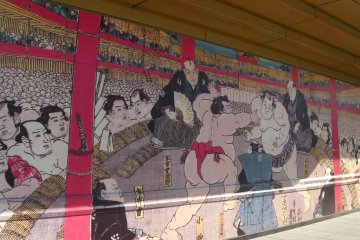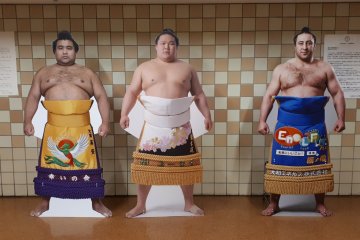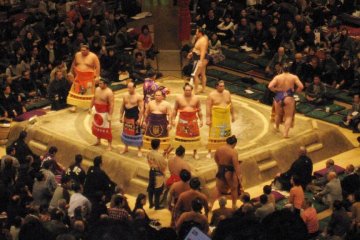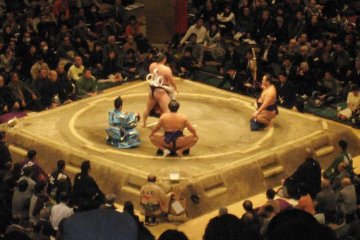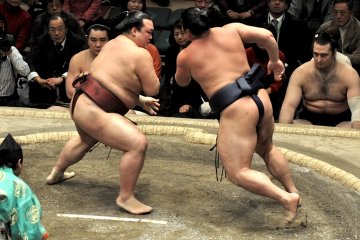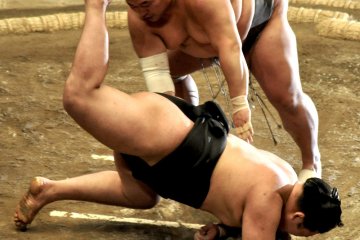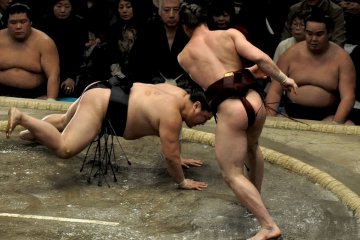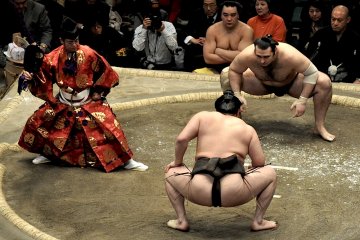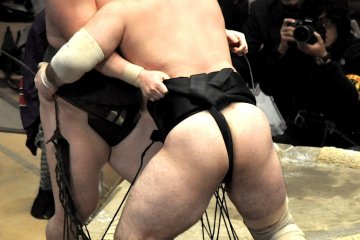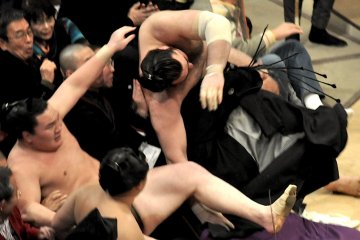Leg-pounding, face-slapping, belly-whacking, salt-throwing, belt-grabbing, bow-twirling, crowd-screeching, heart-pumping…A day at sumo is a wonderful assault on the senses.
Every year there are six honbasho (official sumo tournaments) in Japan. Three are held in Tokyo, and one each in Osaka, Nagoya and Fukuoka. I recently went along to the first honbasho of 2012 at Ryogoku Kokugikan in Tokyo.
From early morning to mid-afternoon the lower ranked rikishi (wrestlers) battle it out. The stadium is pretty empty at this time, although it starts filling up around lunchtime. If you’re up for making a whole day of it it’s worth going along for the experience and also because you can occasionally see some young hopefuls climbing up through the ranks.
At around 2.20pm the jūryō division, the second-highest, takes the stage. These guys are good, and some of them are on their way to being excellent. The division is fixed at 28 rikishi and each has to fight in 15 bouts in a honbasho. That’s 15 days in a row slamming into your opponent, and trying everything in your repertoire to get them out of the ring or to touch the ground with anything but the soles of their feet before they do the same to you. Ouch.
While you’re at the stadium make sure you wander around to have a good look at everything. Pop into the small but very interesting sumo museum on site (free admission) to see the beautiful antique keshō-mawashi (ornate, ceremonial aprons worn by the top divisions of rikishi). Also check out the Emperor’s Cup in the foyer of the stadium. This is awarded, along with many other prizes, to the winning rikishi on the last day of the honbasho.
But whatever else you do with your day, make sure that you’re in your seat by 3.45pm because this is the bit that you’ve paid your money for. The makuuchi division contains the top 42 rikishi in the world and these are the hardest fighting, most experienced players who have the most to lose. The building tension in the stadium was palpable as spectators chanted for their favourites. Like the jūryō, these guys also fight in 15 bouts over the course of the honbasho.
The makuuchi division begins with dohyō-iri (ring entering ceremony) where all the wrestlers enter the ring in turn and carry out a ritual to attract the attention of the gods. The highest ranking rikishi then performs his own ritual of clapping, showing his palms to the gods so they can see he is unarmed, and stamping to drive out the evil spirits from the ground. Once the stage is set, the fighting can begin.
In the makuuchi division, heights range from around 165cm to over 2 meters, while weights range from around 95kgs to nearly 200kgs. For me, the most interesting bouts were between rikishi who were physically mismatched, and therefore the smaller guy had to employ more tactics (slapping, ducking, running, arm-locking) rather than just relying on his mass to bulldoze his opponent out of the ring. There are 70 official winning moves at the rikishi’s disposal and each player has his own distinctive style.
Some bouts lasted a couple of seconds, others nearly a minute. It’s not necessarily the length of the fights for which you go to see sumo, it’s more about experiencing something uniquely Japanese in its ritual, pomp and circumstance. Having said that, do look out for the non-Japanese rikishi – in the makuuchi division there are currently four men from Mongolia, two from Bulgaria and one each from Brazil, Czech Republic, Estonia and Russia. Legend has it that one of these guys had to dye his blonde hair black and get extensions so that he was able to have the traditional and obligatory chomage (topknot) hairstyle.
The final act of the sumo day is yumitorishiki (bow-twirling ceremony). After all the members of the makuuchi division have battled it out, a third division rikishi enters the ring and twirls a long bow around his head, celebrating the achievements of all the winning rikishi that day. Keep your fingers crossed that he doesn’t drop the bow – if this happens he must pick it up with his foot as to touch your hand to the floor in sumo is to lose and it would be very bad luck to do this in the final ceremony of the day.
And so the sun set on my day at the sumo. As with many things in this country, nothing at the honbasho is done without a reason, whether it’s to honour the gods, to bring fortune or to drive away evil. I would highly recommend it as an insight into some of the intricacies of Japanese ritual and tradition. It’s also seriously good fun!



